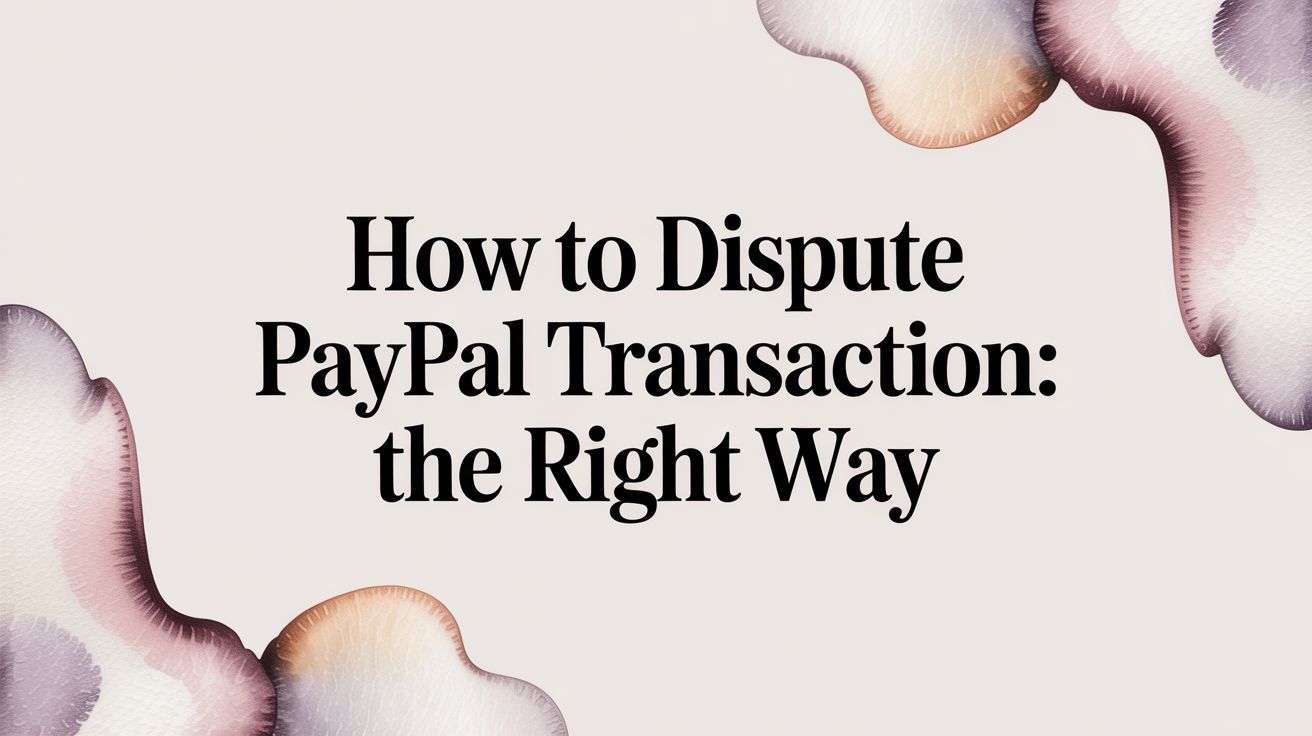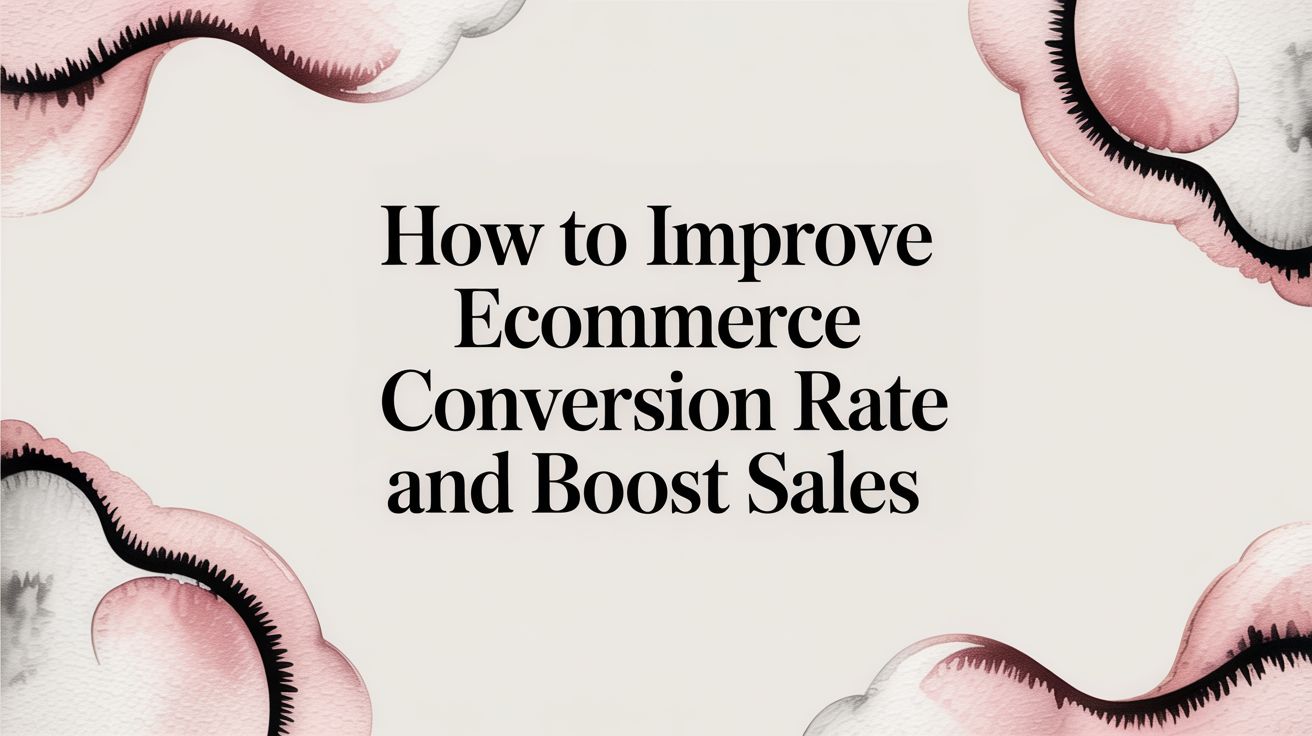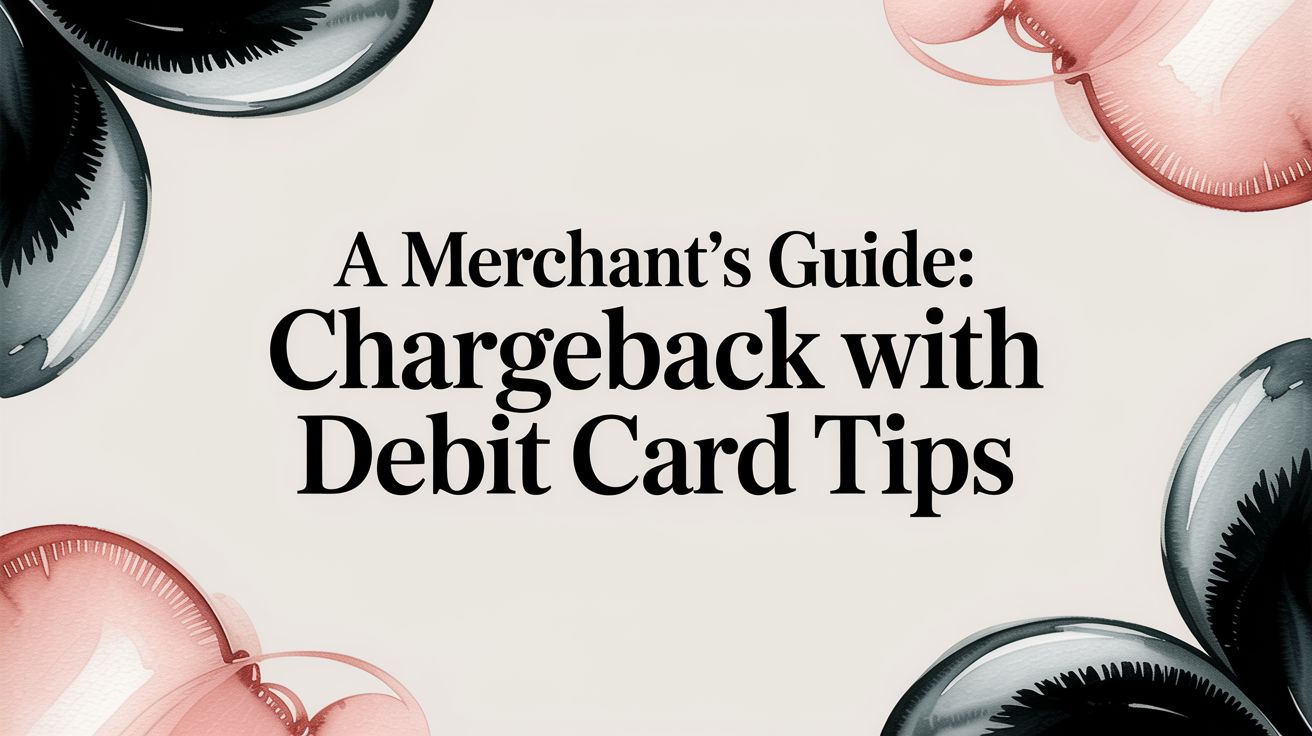
So, how long does a chargeback actually take? The short answer is most cases wrap up within 30 to 90 days. But let's be real—that’s just a ballpark. The actual timeline can be a lot more unpredictable, and it really depends on the specifics of the situation.
What Merchants Can Realistically Expect
Think of the chargeback process less like a quick refund and more like a mini court case. It's a formal back-and-forth between three key players: the customer, their bank, and you, the merchant. Each step in this journey has its own schedule, and just getting a handle on this flow is the first step toward managing your expectations and protecting your revenue.
This whole thing kicks off the moment a customer calls their bank to dispute a charge. From that point on, a formal process begins, pulling in multiple parties and triggering deadlines that can easily stretch the resolution from a few weeks into several months.
Chargeback Timeline at a Glance
To give you a clearer picture, this table breaks down the average time for each stage. It helps you see exactly where the time goes during a typical chargeback lifecycle.
As you can see, the process is built on a series of reviews and response windows. This structure ensures everyone has a fair chance to present their case, but it also means there are no shortcuts.
Key Factors Shaping the Timeline
The duration of a chargeback isn't set in stone. Several things can either pump the brakes or hit the accelerator on a final decision.
Here are a few of the most common factors:
- Card Network Rules: Every payment network—Visa, Mastercard, American Express—plays by its own rulebook and sets its own deadlines. They’re not all the same. For a deeper dive into one of the major players, you can learn more about the specifics of American Express chargeback time limits in our guide.
- The Reason for the Dispute: A straightforward claim of fraud might get resolved relatively quickly. But a more subjective issue, like a "product not as described" claim, almost always requires more detailed evidence from both you and the customer, which takes more time to gather and review.
- Response Times: This one is huge. How quickly you and the banks respond at each stage plays a massive role in the overall speed of the resolution. Delays at any point can have a domino effect on the entire timeline.
The entire system is built on a series of required waiting periods. These are designed to give every party—the customer, their bank, your bank, and you—enough time to review information and respond, which is why a quick resolution is rare.
Just to give you an idea of the variability, Visa generally allows customers up to 120 days from the transaction date to even start a chargeback, with most cases getting resolved within 45 to 75 days. Mastercard’s timeframe can also easily stretch to 75 days or more. The key takeaway? Patience isn't just a virtue here; it's a necessity.
Navigating the Chargeback Lifecycle Step by Step
To really get a handle on how long a chargeback takes, you have to see it as a journey, not a single event. It's a series of handoffs between the customer, their bank, your bank, and you, with each stage having its own unique timeline. Let's break down exactly what happens at each stop along the way.
This visual timeline shows how these stages typically play out, giving you a clearer picture of the timeframes involved.

As you can see, while some disputes wrap up relatively quickly, the full process can easily stretch to 90 days—and in more complex cases, it can even push past the 120-day mark.
Stage 1: The Dispute Initiation
It all starts when a customer calls their issuing bank (the bank that gave them their credit card) to question a charge. This is the official starting gun. The customer will explain why they think the charge is wrong, maybe claiming fraud, that a product never arrived, or there was a simple billing error.
The issuing bank then looks at the claim to see if it fits under one of the official chargeback reason codes set by card networks like Visa or Mastercard. If it does, the wheels start turning. Crucially, the bank often gives the customer a provisional credit within a few days to a week, making them whole while the investigation gets underway.
Stage 2: The Investigation and Representment
Once the issuing bank validates the dispute, it officially files the chargeback. This is a critical moment for you. The disputed money, plus a chargeback fee, is immediately pulled from your merchant account. You’ll then get a notification spelling out the reason for the dispute.
This kicks off your window to respond—a stage called representment. This is your one and only shot to fight back by providing compelling evidence that proves the transaction was legitimate. The clock is ticking, and the deadlines are incredibly strict. For a deeper dive into this phase, you can explore the entire card dispute process in our detailed guide.
The deadline for representment is non-negotiable and starts from the dispute date, not the day you receive the notification. Missing it means an automatic loss.
Deadlines are set by the card networks and they don't mess around:
- Mastercard: You generally get 45 days to submit your case.
- Visa: The window is often tighter, around 20 days.
Stage 3: Pre-Arbitration and Arbitration
After you send in your evidence, the issuing bank takes a look. If what you provided is strong enough to poke holes in the customer's claim, the chargeback gets reversed, and the money is returned to your account. Case closed.
But what if the bank still sides with their customer? The chargeback stands. At this point, you have a decision to make. You can either eat the loss or escalate the case.
The next potential step is pre-arbitration (sometimes called a second chargeback), where you get another chance to present evidence. If the dispute still isn't resolved, the final, last-ditch option is arbitration. This is where the card network itself steps in to act as the final judge. Be warned: this stage is expensive, with hefty fees involved, and the decision is binding on everyone. Because of the cost and complexity, arbitration is pretty rare and usually only reserved for high-value disputes where a merchant is absolutely confident in their evidence.
Why Some Chargebacks Move Slower Than Others

Have you ever wondered why one chargeback wraps up in a month while another seems to get stuck in limbo forever? It’s not just you, and it’s definitely not random. Several factors can act like traffic signals for a dispute, either waving it through a green light or hitting it with endless reds.
Think of it this way: each major card network—like Visa, Mastercard, and American Express—has its own playbook. They all set different deadlines and follow slightly different procedures for handling disputes. A timeline that’s completely normal for one network might be way off for another, which is a huge reason for the variation you see.
The Role of Dispute Reason and Evidence
The "why" behind the chargeback plays a massive part in how long it takes. A straightforward claim, like a duplicate charge, is pretty easy for a bank to verify and fix. It’s a simple clerical error that can be resolved quickly.
But a more subjective dispute, like a customer claiming a “Product Not as Described,” is a whole different ballgame. This kind of claim requires a deep dive into the evidence from both sides. You’ll be digging up product descriptions, photos, and customer emails, while the customer submits their side of the story. All that back-and-forth adds serious time to the clock.
The quality of your evidence is another make-or-break factor for speed.
- Clear and Concise: Submitting organized, easy-to-understand proof helps the bank make a much faster decision.
- Irrelevant Information: Sending a jumble of unrelated documents just creates confusion and slows everything down.
- Missing Proof: If you can’t provide a key piece of evidence, like shipping confirmation, the case will almost certainly drag on.
In short, the cleaner your proof, the faster the resolution. Sometimes, before an official chargeback is even filed, a bank might ask for more details. This is known as a retrieval request, and you can learn about the key differences between retrieval requests vs chargebacks in our helpful article.
A well-documented case with compelling evidence is like taking the express lane through the dispute process. A case built on weak or disorganized proof is stuck in rush-hour traffic.
The Impact of Volume and External Factors
Finally, some delays are completely outside your control. The sheer volume of chargebacks being processed across the globe can create a major bottleneck for banks and card networks.
This operational strain is only getting worse. Globally, the number of chargebacks is projected to hit 337 million by the end of 2025—that’s a 27% jump since 2022. This surge puts a massive strain on the system, especially in sectors like travel and e-commerce, which saw chargeback increases of 816% and 222% respectively between 2023 and 2024. When the whole system is overloaded, every single case tends to move a bit slower.
The Hidden Costs of a Lengthy Dispute
When you get hit with a chargeback, it's easy to fixate on the most obvious loss: the sale itself. But a long, drawn-out dispute is like an iceberg. What you see on the surface is just a fraction of the problem; the real damage is happening quietly, just out of sight.
A lengthy chargeback isn't just a minor annoyance—it’s a slow, expensive drain on your entire business. The longer that dispute sits unresolved, the more these hidden costs start to pile up, hitting both your bottom line and your team's ability to focus on what matters.
The Financial Bleed Beyond the Sale
First, let's talk about the direct hits to your bank account that have nothing to do with the original transaction. Every single time a customer files a chargeback, your payment processor slaps you with a non-refundable administrative fee. These fees can add up shockingly fast, especially when you have several disputes tying up revenue for months on end. If you want to dig deeper into how these penalties work, you can explore the details behind a chargeback fee in our comprehensive article.
Then there's the cost of the actual goods. If you've already shipped the product, you're out both the item and the money from the sale. A long dispute just prolongs the agony, leaving your inventory and accounting in a state of limbo.
It's often said that the true cost of a chargeback is more than double the original sale price. Why? Because that number has to account for the lost revenue, all the fees, the operational costs, and even the money you spent to acquire that customer in the first place.
This financial strain isn't just a merchant problem. On average, it costs banks between $9.08 and $10.32 per case just to process a dispute. This shows that getting to a quick resolution is better for everyone involved. Some industries feel the pain more than others; travel and hospitality, for instance, see the highest average chargeback value at around $120 per case. For merchants trying to handle this all in-house, the manual work just makes everything take longer and cost more. You can find more insights on this in Mastercard's 2025 report on the true cost of a chargeback.
The Operational Strain on Your Team
Money isn't the only thing you're losing. A long dispute quietly eats away at your most precious resource: your team's time. Every hour someone spends dealing with a chargeback is an hour they aren't working on growing the business.
Think about the real-world operational burden:
- Wasted Time on Evidence: Your team has to drop everything to go on a digital scavenger hunt—digging up order details, finding shipping confirmations, pulling customer emails, and trying to stitch it all together into a case that might actually win.
- Tied-Up Support Staff: Your customer support team can get bogged down in endless back-and-forth emails and calls about a single dispute, which keeps them from helping other, happier customers.
- Risk to Your Merchant Account: A high number of unresolved, aging disputes inflates your chargeback ratio. If that number climbs too high, you could be looking at steeper processing fees or, in a worst-case scenario, the termination of your merchant account.
When you add it all up, the conclusion is simple. Responding to a chargeback quickly and effectively isn't just about winning back one sale. It's a critical strategy for protecting your money, your time, and the long-term health of your business.
How Merchants Can Actively Speed Up Resolution

While you don't control the entire chargeback timeline, you're definitely not just a passenger along for the ride. Taking decisive, organized action can seriously influence both how fast a dispute is settled and what the final outcome is. It's all about shifting from a reactive "oh no, a chargeback!" mindset to a proactive one.
Think of yourself as a detective building a solid case. The stronger your evidence and the faster you present it, the quicker you'll get a resolution. This work starts long before a dispute ever lands on your desk, beginning with meticulous record-keeping. Every piece of data—order forms, customer service emails, shipping confirmations with tracking numbers—is a potential piece of game-winning evidence.
Gather Your Compelling Evidence
The moment a chargeback notification hits your inbox, the clock starts ticking. Loudly. You won't have time to leisurely hunt for documents. This is why having a system in place to quickly pull the right proof for the specific claim is absolutely critical.
Here’s a practical checklist of evidence you should have ready for common dispute types:
For "Product Not Received" Claims:
- Proof of Delivery: This is your silver bullet. A shipping confirmation with a tracking number that clearly shows the item was delivered to the customer's address is non-negotiable.
- Customer Communication: Grab any emails or chat logs where the customer acknowledges their order or discusses shipping details.
For "Fraudulent Transaction" Claims:
- AVS and CVV Match: Show that your address verification system (AVS) and card verification value (CVV) checks came back as a match during the purchase.
- IP Address Geolocation: Provide data showing the IP address used for the purchase matches the customer's billing or shipping location.
- Order History: Dig up evidence of previous, undisputed purchases from the same customer, IP address, or device.
The goal here is to paint a crystal-clear, undeniable picture for the issuing bank. Your evidence needs to be so compelling that it leaves zero room for doubt about the transaction's legitimacy, forcing a faster, more favorable decision.
Act Fast with Modern Tools
In the chargeback world, speed is everything. The deadlines for responding are strict and they don't bend—you often have just 20-45 days. Responding right away shows you're on top of things and serious about the dispute, which can encourage a quicker review from the bank.
This is where modern technology really changes the game. Instead of manually digging through spreadsheets and email archives, you can use tools that handle the heavy lifting. Chargeback alerts, for example, can notify you of a potential dispute before it becomes an official chargeback. This gives you a golden opportunity to issue a refund and sidestep the entire messy process.
Even better, chargeback management software can automate the evidence collection for you. These platforms plug right into your sales and shipping systems to instantly pull all the necessary documents, build a response packet, and submit it on your behalf. Not only does this save a ton of time, but it also makes sure you never miss a critical deadline.
Ultimately, the best way to speed up a resolution is to stop the dispute from ever happening. If you want to proactively manage potential issues and avoid them altogether, it's worth implementing effective chargeback prevention strategies to protect your business from the get-go.
Common Questions About Chargeback Timelines
Even with a clear map of the chargeback journey, you’ve probably still got some questions about how long things can really take. Let's break down some of the most common things merchants ask about the process and its timing.
Can a Chargeback Be Resolved in Less Than 30 Days?
It's possible, but it's incredibly rare once a dispute becomes a formal chargeback. Think of it this way: the fastest resolutions happen before the official game even starts.
This usually happens when a merchant uses an alert service to catch a dispute early and just issues a refund directly, stopping the chargeback in its tracks. If a customer changes their mind and withdraws their claim early on, that can also wrap things up quickly.
But once that chargeback is officially filed and you’re in the representment stage, the built-in waiting periods for both you and the banks make a resolution in under a month highly unlikely.
What Happens if I Miss the Response Deadline?
Missing the deadline to submit your evidence is the equivalent of forfeiting the match. You automatically lose the dispute. The money is gone for good, and there are no second chances or appeals.
This is a hard and fast rule. The response window is usually between 20 and 45 days, depending on the card network, so acting fast isn’t just a good idea—it’s the only way to even have a chance of winning.
Think of the response deadline as a locked door. Once it closes, there's no way to get your evidence in front of the decision-makers. Promptness isn't just a good practice; it's a requirement to even participate in the process.
Does the Dispute Reason Affect the Timeline?
Yes, absolutely. The reason code behind the chargeback has a huge impact on how long the whole thing drags on. A dispute for a straightforward fraudulent transaction often requires a very different set of evidence than a claim for "Product Not Received."
Disputes over services or digital goods can get especially complicated and take longer to sort out because you have to prove delivery or access in a less tangible way. A simple case with clear-cut proof, like a delivery confirmation with a signature, will almost always move faster than a subjective claim like "Product Not as Described," which can turn into a long back-and-forth between everyone involved.
Is There a Time Limit for a Customer to File a Chargeback?
Yes, and this is a big one. Card networks set specific time limits, often called the "dispute window." For most transactions, a customer has 120 days from the transaction date to file a dispute.
But it’s not always that simple. In some situations, the clock doesn't start ticking from the purchase date but from the date the customer discovered the problem. It's really important for merchants to have a basic handle on these rules, as they dictate how long you’re on the hook for a potential dispute after a sale. For a deeper dive, you can explore the different factors that determine the time limit for a chargeback on a credit card.
Struggling to keep up with tight deadlines and complex evidence requirements? ChargePay uses AI to automatically generate and submit winning dispute responses on your behalf, turning a months-long headache into a hands-free process. Stop losing revenue to manual errors and missed deadlines—see how ChargePay can boost your win rate today.







.svg)







.svg)
.svg)
.svg)